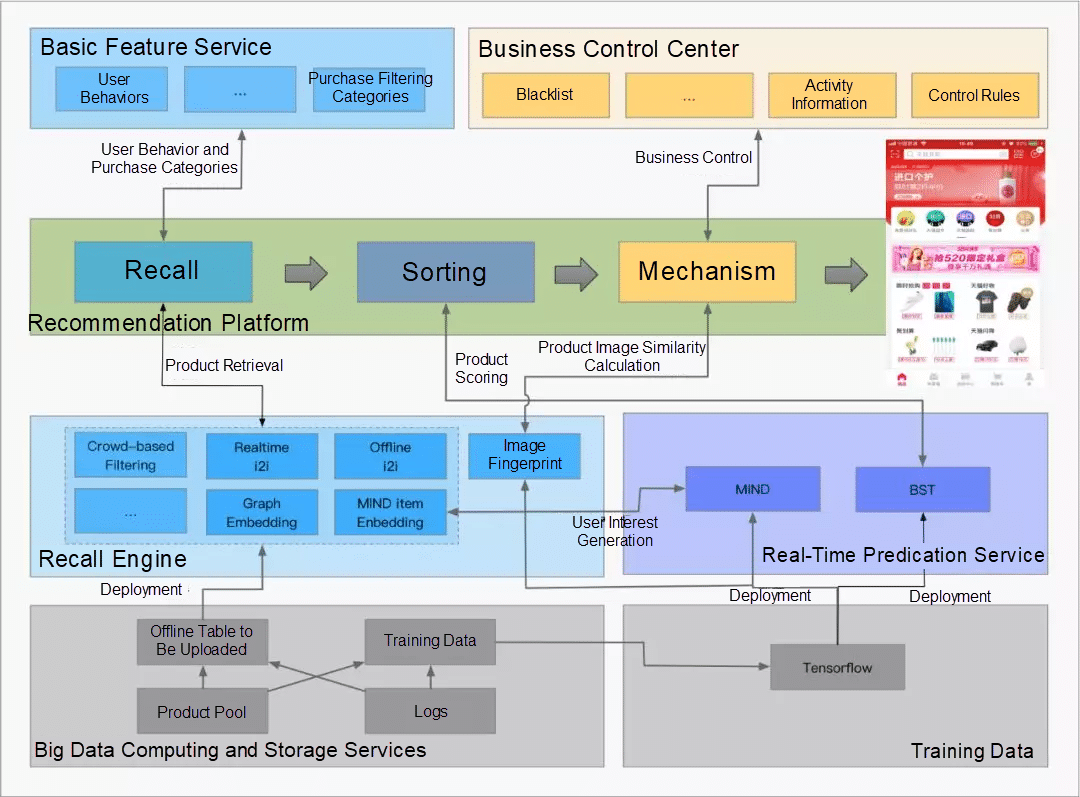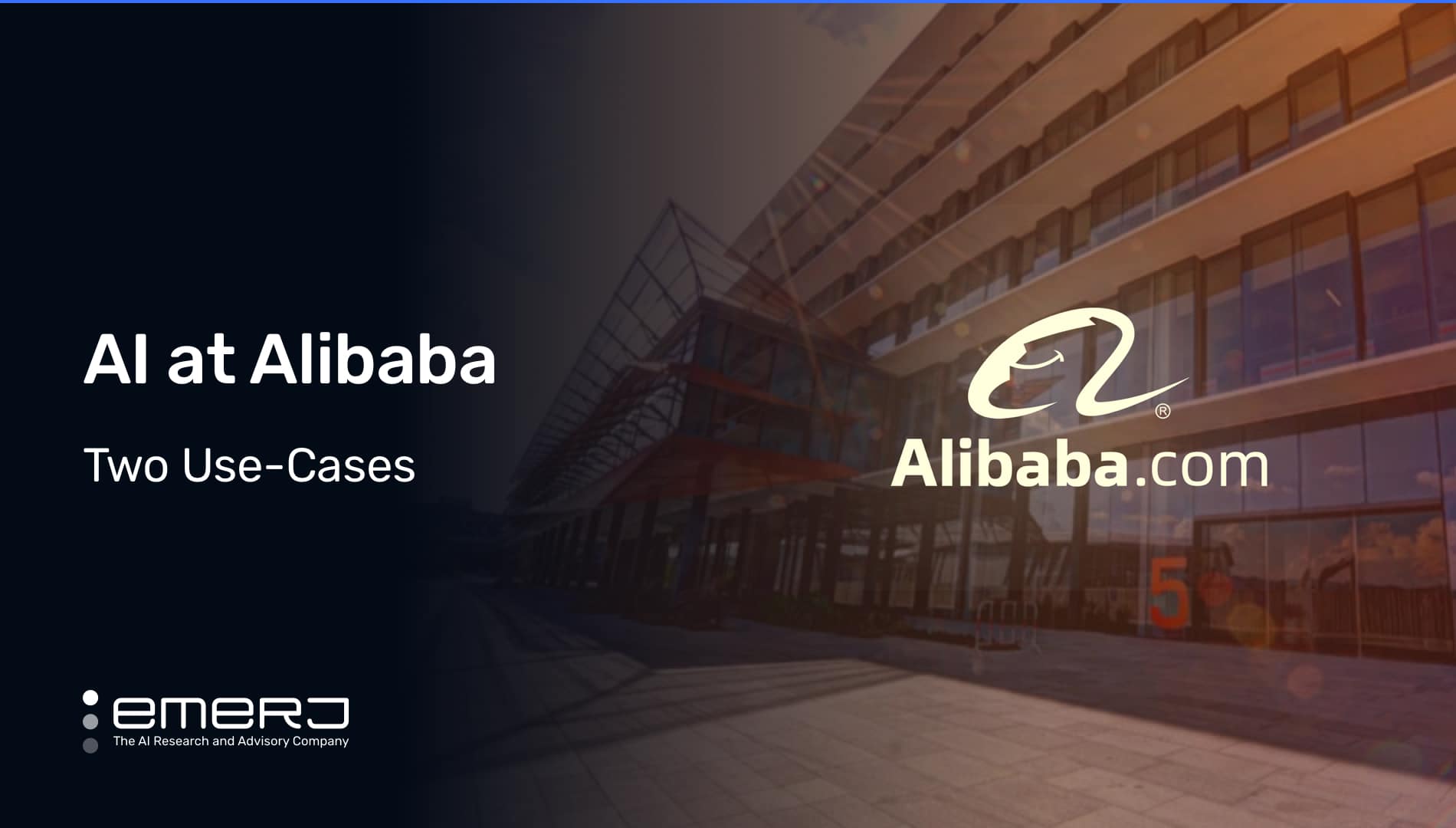Per Alibaba’s annual report, its revenue in 2021 exceeded 717 billion yuan (approximately 109 billion U.S. dollars), while its active yearly customers reached nearly 1.3 billion people. As of March 2022, Alibaba trades on the NYSE and has an approximate market cap of $225 billion.
Internal and external evidence suggests that Alibaba is aggressively researching and implementing AI and machine learning solutions. Such evidence includes:
- A $15 billion investment in its DAMO academy, including in research areas that focus on data intelligence, IoT, human-machine interaction, and quantum computing.
- A $1.4 billion investment in its AI system for smart speakers.
- A $600 million investment in SenseTime, a deep learning and computer vision company.
In this article, we’ll examine how Alibaba has used AI applications for its business and industry through two distinct use-cases:
- Driving Sales with Optimized Recommendation Systems – Alibaba uses intelligent recommendation algorithms to drive sales using personalized customer search recommendations on its Tmall homepage and mobile app.
- Cloud AI to Support Variable Sales/Traffic Volumes – The company uses AI cloud to help reduce its computation load and increase product sales for its annual ‘Double 11’ Global Shopping Festival.
First, we will analyze how Alibaba uses its recommendation system framework’s algorithms to retrieve products based on customer search activity.
Driving Sales with Recommendation System Framework
Alibaba is the largest e-commerce company by Gross Merchandise Volume (‘GMV’) globally (it more than doubles Amazon’s GMV numbers.) As with any e-commerce enterprise, it is vested in maximizing revenue by optimizing the virtual shopping experience and recommending the most comparable products.
Alibaba claims nearly 1.3 billion active global users across its ecosystem. Managing this amount of traffic while optimizing the shopping experience requires prodigious use of AI, particularly machine learning and cloud AI functions.
The idea behind Alibaba’s Recommendation System Framework (RSF) is simple: optimize traffic flow while updating and offering relevant products to TMall consumers that they want to buy. Moreover, to perform these operations in real-time, thereby increasing customer satisfaction clickthrough rate, and company revenue.
Prior to 2019, the company used a “relevance of recommendation” function, which calculates the “degree of similarity between the previous products clicked on and/or purchased with TMall’s inventory.” However, Alibaba changed this function to include “diversity of recommendation” and “discovery optimization” using what the company calls its Artificial Intelligence Recommendation (AIRec) engine. Notably, Alibaba claims that its AIRec algorithms outperform “self-managed” algorithms by 20-100%.
The following video goes into some more detail about Alibaba’s updated recommendation system:
The company claims that the AIRec engine can analyze and capture user behavior in seconds and provide personalized recommendations within milliseconds. Another way to the above from our research is: “We’re focusing more on offering customers more diverse products that (also) have a high clickthrough rate.”
As for the inputs to the model, Alibaba purports that their updated homepage RSF includes four “modules”:
- Based on user input (clickthroughs, add-to-cart, etc.), the recall module retrieves products that the user may be interested in real time. A similarity score (‘simScore’) is queried using a CF algorithm based on user selection data. CF (“collaborative filtering”) filters out items that a user may like based on the actions of both the active user and similar users. This training data is transferred to the sorting module.
- The sorting module is a deep learning program that uses the product data retrieved from the recall module, refines it, and assigns a product score based on additional criteria. The primary feature of the sorting module appears to be the BST (“behavior sequence transformer”) model, which learns the correlation between user behavior sequences and product data extracted from the recall module.
- The mechanism module is said to adjust system algorithm strategy, control traffic, optimize user experience, and sort products. A “product image similarity calculation” also occurs in this module using a Convolutional Neural Network (CNN), presumably to ensure the product(s) match before presenting it to the end-user in the form of a recommended product.
- Finally, the recommendation system retrieves the products that match the final algorithmic operations performed in the mechanism module. These products are then placed in various places on the homepages in real time.

Given the number of variables that impact subsidiary success or failure and the lack of a dedicated metric measuring AI impact on revenue, it’s difficult to quantify the bottom-line business impact. The company states that TMall has become the world’s largest ‘third-party online and mobile commerce platform…in terms of GMV (Gross Merchandise Volume).” The company also reports a 19 percent YOY revenue increase in its TMall operations from 2019 to 2020, when the newer algorithmic processes were implemented.
Cloud AI at Alibaba’s Flagship Shopping Event
Cloud AI is expanding rapidly thanks to rapid advances in computing power, new AI tools, and software that delivers a more economical option for data storage. AI algorithms require significant computing power, the price of which is out of reach for most enterprises. The global cloud AI market is expected to increase by $10.22 billion between 2021 and 2026, including YOY growth in 2022 of 20.26%.
It isn’t just economics that inclines the user of AI towards the cloud – it’s also scalability. Alibaba is a good case study in this respect. The company states that their “Double 11” festival required the prolific use of cloud-based AI. “It was challenging for the (Alibaba) Group to deal with such copious amounts of computational resources and scale resources on demand by relying on an on-premises solution,” thereby requiring an “off-premises” (read: cloud-based) solution.
Alibaba holds an entirely “online global shopping festival” on ‘“Singles Day,” or November 11. In recent years, the company has extended the event to 11 days (Nov 1 to Nov 11). It is a massively ambitious undertaking that requires a profuse amount of computing power. Here are some purported numbers from the most recent festival:
- $84.54 billion in gross merchandise volume (herein ‘GMV’)
- 800 million customers
- 290,000 brands
- A peak of 583,000 transactions per second
Alibaba claims to have achieved this computational scale through AI cloud operations and related apps. Let’s discuss the distinct ways they accomplished this feat.
According to the company, the festival’s cloud infrastructure relied on three critical technologies. Here are those three technologies and the purported results:
- Elastic Computing Service (ECS): Alibaba claims that their elastic computing setup allowed them to “help our customers realize a 30 percent increase in the queries-per-second rate and decrease latency by 60 percent. Experts say that elastic computing is more effective and efficient than physical servers, as it permits users to scale computing resources instantly. It is also said to be more reliable, cost-effective, and stable.
- Cloud Content Delivery Network (CDN): Alibaba claims that they were able to “reserve over 100 Tbps of bandwidth for dozens of services” due to their use of CDN. A CDN is the cloud’s equivalent of physical servers. Alibaba claims that some of the benefits of its use include:
-
- Faster content availability
- Enhanced site load times
- Improved site security
- Reduced bandwidth costs
- Elastic GPU Service: Alibaba claims that elastic GPU helped it reduce its livestream latency to less than 1 second, which they state is 75% lower than the industry average. In theory, elastic GPU is claimed to improve network coverage, computing power, and network performance.
It is difficult to gauge the business impact of the cloud AI variable in isolation. In theory, such massive infrastructural changes that Alibaba alleges that it made using 100% cloud AI resources may have a significant monetary impact. More quantifiably, the 2021 festival is reported to have earned approximately $84 million, while the ‘20 festival is reported to have earned $56 million – a 50% YOY increase.




















